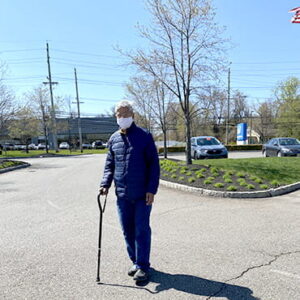07 Dec How AI Helped Me Learn to Write Again
The following article was originally published by American Stroke Association on December 7, 2023, on their website.
Mukul Pandya is a stroke survivor and a former editor-in-chief of Knowledge@Wharton, the online management journal of the Wharton School of the University of Pennsylvania. In this column he shares his personal experience of recovering from a stroke. He discusses how he realized that recovery didn’t have to mean getting back to where he was, and how he used artificial intelligence tools to help rebuild a meaningful and rewarding professional life.
Today, Mukul is an associate fellow at Oxford University’s Said Business School and working with Stroke Onward to drive change in the health care system to provide whole-person support to stroke survivors and their families. This column is an updated version of a longer essay written in 2021.
 Two years ago, a pontine lacunar stroke upended my life as I knew it. Such strokes occur when an artery that supplies blood to a deep part of the brain is blocked. The stroke robbed me of the use of the left side of my body. More significantly, I lost the ability to write and edit, my primary modes of expression and identity. I did not suffer from acute aphasia, though I began to slur my words. After a while, I could sense when my tongue was about to mangle a word and switch to a different one.
Two years ago, a pontine lacunar stroke upended my life as I knew it. Such strokes occur when an artery that supplies blood to a deep part of the brain is blocked. The stroke robbed me of the use of the left side of my body. More significantly, I lost the ability to write and edit, my primary modes of expression and identity. I did not suffer from acute aphasia, though I began to slur my words. After a while, I could sense when my tongue was about to mangle a word and switch to a different one.
As a professional writer and editor since the late 1970s, for decades, words had been the tools of my trade. More fundamentally, they were the medium through which I connected with the world. Losing the ability to write felt like being trapped in an underground dungeon, watching as the essence of who I was ebbed away.
How miserable those early days were! The prospect of living without being able to write or share stories seemed unbearable. While I did not become actively suicidal, on the darkest days the words of La Pasionaria, a revolutionary in the Spanish Civil War, echoed through my mind: “It is better to die on your feet than to live on your knees.”
Turning point
A key turning point came when, while searching for books that could help me deal with my disability, I learned about Identity Theft: Rediscovering Ourselves After Stroke by Debra E. Meyerson and Danny Zuckerman, her son. I saw that two of my former colleagues had endorsed it, and I quickly ordered a copy.
One of the first and most valuable lessons I learned from Identity Theft was the meaning of recovery. In the first days after the stroke, I had naively imagined that I would bounce back to being the person I had been in a few months. Meyerson’s book helped me realize that in life one can’t bounce back; one has to bounce forward. Recovery meant coming to terms with the new normal of my post-stroke capabilities and building a meaningful life around them.
Further salvation came in an unexpected guise: the fast-emerging field of artificial intelligence (AI) and assistive technology. My tentative first steps were powered by the simplest of tools from my smartphone and laptop — predictive text that finished my sentences, speech-to-text functions that gave my voice a digital form, and one of my apps allowed me to communicate with friends around the world via voice messages. These became my lifelines. Once I was able to start answering my own emails, some of my agency returned. A ray of light broke through the darkness.
A major breakthrough came with the discovery of an AI-driven transcription service that became my scribe, listening attentively to my spoken words and transforming them into written text. With this tool, I was able to dictate my thoughts and see them played back on the screen — not just as transcribed words, but as a reconstruction of my identity as a writer.
Editing the transcriptions became a therapeutic process through which I reshaped my articles and, in turn, rebuilt my self-worth. Each word I edited was a brick that helped me reconstruct my shattered identity. I was no longer just a stroke survivor; I was a writer, reborn.
Continuing my AI journey
 My journey with AI did not stop there. I began to explore more advanced generative AI tools which became my collaborative partners in the creative process. They seemed to have turned into extensions of my will, helping me piece together stories, craft articles and engage with readers once more. AI can do much more than generate text. Images are another way that you can use these tools to express yourself. I created this image using an AI tool using a few words to prompt the design creation.
My journey with AI did not stop there. I began to explore more advanced generative AI tools which became my collaborative partners in the creative process. They seemed to have turned into extensions of my will, helping me piece together stories, craft articles and engage with readers once more. AI can do much more than generate text. Images are another way that you can use these tools to express yourself. I created this image using an AI tool using a few words to prompt the design creation.
The process of relearning to write was an intricate waltz between human creativity and the mechanical precision of AI. I would initiate the writing process with my thoughts and ideas. Then AI, with its swift and tireless algorithms, took on the task of transcribing the audio narratives into text. Finally, in the review and editing of this text, my human judgment came into play, sculpting the raw material into finished pieces of writing.
As I pieced together sentences and paragraphs, my professional identity began to take shape. The act of writing, facilitated by these advanced tools, rebuilt my resilience. Friends and colleagues played an integral role in this process. They entrusted me with writing projects, challenging me to engage my skills and pushing me towards recovery. Their confidence in my ability was a crucial component of my rehabilitation.
The collaboration with AI became a structured workflow. You begin with a human task; follow with a narrow task that AI can manage; and end with a task requiring human oversight. It is a blueprint for overcoming disability, a strategy that can be replicated and customized for others facing similar challenges. My growing relationship with AI proved that the tools of the digital age can serve as extensions of our capabilities, offering a pathway back to productivity and purpose.
My experience has taught me that for those navigating the aftermath of a stroke or other life-altering disabilities, the fusion of human willpower with the right tools can lead to extraordinary outcomes. My experience is not unique. It’s the story of every individual who, in the face of adversity, finds ways to adapt. It’s a message of hope for all stroke survivors, emphasizing that our identities and abilities are not lost; they are waiting to be reborn and redefined through persistence. Technology tools, and especially AI, may be able to help.
In sharing this story, my objective is to showcase that the collaboration between human endeavor and artificial intelligence can not only restore what was lost but can also propel us to new heights. You are stronger than your stroke. Never give up. Your capabilities, your identity, your purpose — these are yours to reclaim. With AI as your ally, the journey ahead is one of hope, transformation and uncharted potential. May you embrace these AI tools not as crutches but as wings. May you rebuild your identities and your lives.
For me, AI helps me write and edit again — that’s how I find meaning. Where might those wings help you fly to rebuild meaning, purpose and a rewarding life?

No Comments